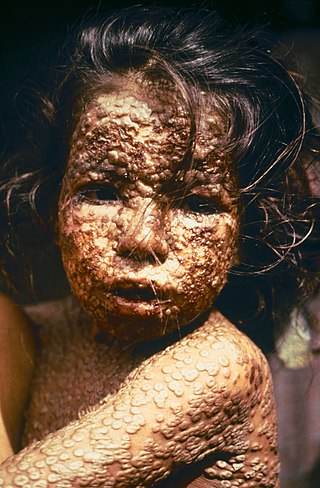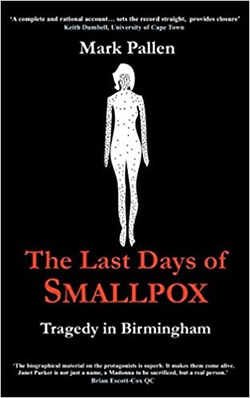
Measles is a highly contagious, vaccine-preventable infectious disease caused by measles virus. Symptoms usually develop 10–12 days after exposure to an infected person and last 7–10 days. Initial symptoms typically include fever, often greater than 40 °C (104 °F), cough, runny nose, and inflamed eyes. Small white spots known as Koplik's spots may form inside the mouth two or three days after the start of symptoms. A red, flat rash which usually starts on the face and then spreads to the rest of the body typically begins three to five days after the start of symptoms. Common complications include diarrhea, middle ear infection (7%), and pneumonia (6%). These occur in part due to measles-induced immunosuppression. Less commonly seizures, blindness, or inflammation of the brain may occur. Other names include morbilli, rubeola, red measles, and English measles. Both rubella, also known as German measles, and roseola are different diseases caused by unrelated viruses.

The smallpox vaccine is the first vaccine to have been developed against a contagious disease. In 1796, British physician Edward Jenner demonstrated that an infection with the relatively mild cowpox virus conferred immunity against the deadly smallpox virus. Cowpox served as a natural vaccine until the modern smallpox vaccine emerged in the 20th century. From 1958 to 1977, the World Health Organization (WHO) conducted a global vaccination campaign that eradicated smallpox, making it the only human disease to be eradicated. Although routine smallpox vaccination is no longer performed on the general public, the vaccine is still being produced to guard against bioterrorism, biological warfare, and mpox.

Mpox is an infectious viral disease that can occur in humans and other animals. Symptoms include a rash that forms blisters and then crusts over, fever, and swollen lymph nodes. The illness is usually mild, and most of infected individuals recover within a few weeks without treatment. The time from exposure to the onset of symptoms ranges from five to twenty-one days, and symptoms typically last from two to four weeks. However, cases may be severe, especially in children, pregnant women, or people with suppressed immune systems.

The 1978 smallpox outbreak in the United Kingdom resulted in the death of Janet Parker, a British medical photographer, who became the last recorded person to die from smallpox. Her illness and death, which was connected to the deaths of two other people, led to the Shooter Inquiry, an official investigation by government-appointed experts triggering radical changes in how dangerous pathogens were studied in the UK and named after the panel's leader.

Smallpox was an infectious disease caused by variola virus, which belongs to the genus Orthopoxvirus. The last naturally occurring case was diagnosed in October 1977, and the World Health Organization (WHO) certified the global eradication of the disease in 1980, making smallpox the only human disease to have been eradicated to date.

The 1974 smallpox epidemic in India infected 188,000 people, leading to the deaths of 31,000 Indians.
The Massachusetts smallpox epidemic or colonial epidemic was a smallpox outbreak that hit Massachusetts in 1633. Smallpox outbreaks were not confined to 1633 however, and occurred nearly every ten years. Smallpox was caused by two different types of variola viruses: variola major and variola minor. The disease was hypothesized to be transmitted due to an increase in the immigration of European settlers to the region who brought Old World smallpox aboard their ships.

Brincidofovir, sold under the brand name Tembexa, is an antiviral drug used to treat smallpox. Brincidofovir is a prodrug of cidofovir. Conjugated to a lipid, the compound is designed to release cidofovir intracellularly, allowing for higher intracellular and lower plasma concentrations of cidofovir, effectively increasing its activity against dsDNA viruses, as well as oral bioavailability.
The smallpox virus retention debate has been going on among scientists and health officials since the smallpox virus was declared eradicated by the World Health Organization (WHO) in 1980. The debate centers on whether or not the last two known remnants of the Variola virus known to cause smallpox, which are kept in tightly controlled government laboratories in the United States and Russia, should be finally and irreversibly destroyed. Advocates of final destruction maintain that there is no longer any valid rationale for retaining the samples, which pose the hazard of escaping the laboratories, while opponents of destruction maintain that the samples may still be of value to scientific research, especially since variants of the smallpox virus may still exist in the natural world and thus present the possibility of the disease re-emerging in the future or being used as a bio-weapon.
Mark J. Pallen is a research leader at the Quadram Institute and Professor of Microbial Genomics at the University of East Anglia. In recent years, he has been at the forefront of efforts to apply next-generation sequencing to problems in microbiology and ancient DNA research.
Witton Isolation Hospital was a facility for the treatment and quarantine of smallpox victims and their contacts in Birmingham, England, from 1894 to 1966.

Neil Morris Ferguson is a British epidemiologist and professor of mathematical biology, who specialises in the patterns of spread of infectious disease in humans and animals. He is the director of the Jameel Institute, and of the MRC Centre for Global Infectious Disease Analysis, and head of the Department of Infectious Disease Epidemiology in the School of Public Health and Vice-Dean for Academic Development in the Faculty of Medicine, all at Imperial College London.

An outbreak of smallpox in Bradford in 1962 first came to attention on 11 January 1962, when a cook from the children's hospital in Bradford, West Riding of Yorkshire, England, presented with an unexplained fever and was found to have changes in her blood similar to another sick person at the nearby St Luke's Hospital, both samples appearing compatible with smallpox. The index case was later discovered to be a nine-year old girl who arrived in the UK on 16 December 1961 from Karachi, Pakistan, where there was an ongoing epidemic of smallpox.

Henry Samuel Bedson, MD, MRCP, was a British virologist and head of the Department of Medical Microbiology at Birmingham Medical School, where his research focused on smallpox and monkeypox virus.

The Last Days of Smallpox: Tragedy in Birmingham is a 2018 nonfiction account of the events leading up to and following the 1978 smallpox outbreak in the United Kingdom. The author, Mark Pallen, proposes an explanation of how Janet Parker – the last person to die from smallpox – contracted the infection. This explanation, based on court transcripts and interviews with the barrister who defended the University, and the clinicians and scientists who were involved with the outbreak, contradicts the conclusions of the official government enquiry, The Shooter Report.
Alasdair Macintosh Geddes was a British medical doctor who was Professor of Infection at the University of Birmingham Medical School. In 1978, as the World Health Organization (WHO) was shortly to announce that the world's last case of smallpox had occurred a year earlier in Somalia, Geddes diagnosed a British woman with the disease in Birmingham, England. She was found to be the index case of the outbreak and became the world's last reported fatality due to the disease, five years after he had gained experience on the frontline of the WHO's smallpox eradication programme in Bangladesh in 1973.

The Edinburgh City Hospital was a hospital in Colinton, Edinburgh, opened in 1903 for the treatment of infectious diseases. As the pattern of infectious disease changed, the need for in-patients facilities to treat them diminished. While still remaining the regional centre for infectious disease, in the latter half of the 20th century the hospital facilities diversified with specialist units established for respiratory disease, ear, nose and throat surgery, maxillo-facial surgery, care of the elderly and latterly HIV/AIDS. The hospital closed in 1999 and was redeveloped as residential housing, known as Greenbank Village.

Lucas Alfred Derrick Tovey FRCPath, FRCOG, was a British pathologist who shortly after being appointed consultant at St Luke's Hospital in Bradford, West Yorkshire, England, recognised the first cases of smallpox in the early days of the Bradford smallpox outbreak of 1962. Over the subsequent three days a further eight cases of smallpox were detected and Tovey subsequently became in charge of infection control at St Luke's and given the responsibility of liaising with the medical officers of health and the press. He later attributed the successful containment of the outbreak to effective contact tracing, surveillance and vaccination.

Surinder Singh Bakhshi is a British writer and physician, who in 1977 was appointed medical officer of environmental health to the Birmingham Area Health Authority, where he led the successful contact tracing and quarantine effort in the community during the 1978 smallpox outbreak in the United Kingdom.














